Cheese pizza is widely recognized and loved across the globe. Its simplicity and universal appeal have made it a staple in various cultures. Known for its basic yet delicious combination of ingredients, cheese pizza has been embraced as a comforting and versatile dish. The balance of dough, sauce, and cheese is often seen as a perfect culinary harmony, making it a favorite among all age groups.
The Origin and Evolution of Cheese Pizza
The origins of cheese pizza are deeply rooted in Italian cuisine. It was in Italy that the harmonious blend of dough, sauce, and cheese first came to be known as pizza. This simple Italian dish gradually evolved into a global phenomenon, spreading its popularity far beyond Italy’s borders. The adaptability of cheese pizza to various tastes and cultures has played a significant role in its widespread acclaim.
Essential Ingredients for Classic Cheese Pizza
The classic cheese pizza is characterized by its fundamental ingredients: dough, sauce, and cheese. The dough forms the base of the pizza, providing a canvas for the toppings. The sauce, typically made from tomatoes, adds a tangy and rich flavor. The cheese, often mozzarella, is known for its meltiness and rich taste, which completes the pizza. Each ingredient is crucial in contributing to the overall flavor and texture of the pizza, making it a beloved dish worldwide.
Crafting the Perfect Cheese Pizza: A Step-by-Step Guide
A detailed recipe for making cheese pizza from scratch has been developed, focusing on the balance of flavors and textures. The process begins with the preparation of the dough, which is the foundation of the pizza. The dough is then topped with a carefully selected sauce, which adds depth and richness to the flavor profile. The final step involves layering the cheese, which is melted to perfection. This guide provides tips for each step of the process, ensuring a delicious and satisfying cheese pizza.
In the next part of the article, we will explore variations, serving suggestions, and frequently asked questions about cheese pizza.
-
- Explore the nuances between fudgy and cakey brownies, perfect for deciding which type to use in your Brownie Bottom Cheesecake.
- Fudgy vs. Cakey Brownies
Cheese Pizza Recipe:
Cream Cheese Pizza
Cream Cheese Pizza is a unique variation of traditional pizza that incorporates cream cheese into its topping. It’s known for its rich and creamy texture, offering a different taste experience compared to the usual mozzarella-based pizzas. Here’s a basic idea of how to make it:
- Base: Use a standard pizza dough as the base.
- Sauce: You can opt for the traditional tomato sauce or experiment with pesto or Alfredo sauce for a different flavor profile.
- Toppings: Spread a layer of cream cheese over the sauce. You can add other toppings, like smoked salmon, capers, dill, or thinly sliced vegetables, for added flavor and texture.
- Baking: Bake in a preheated oven until the crust is golden and the toppings are heated through.
This type of pizza is often enjoyed as a gourmet option and is particularly popular for brunches or as an appetizer.
Vegan Cheese Pizza
Vegan cheese is made from various non-dairy sources like nuts, soy, and root vegetables, and it melts and stretches similar to traditional cheese. Here’s a simple approach:
- Base: Use a vegan pizza dough (check that it doesn’t contain honey or dairy products).
- Sauce: Tomato sauce is a common choice, but you can also use vegan pesto or barbecue sauce.
- Toppings: Spread a generous layer of vegan cheese. You can add vegetables, vegan meats, or herbs for more flavor.
- Baking: Bake until the crust is crispy and the cheese has melted.
Vegan cheese pizzas are a great alternative for those avoiding dairy without sacrificing the joy of eating pizza.
Cottage Cheese Pizza Bowl
A Cottage Cheese Pizza Bowl is a creative and healthier twist on traditional pizza. It’s essentially a deconstructed pizza with cottage cheese as the base, providing a high-protein and low-carb alternative. Here’s how to make it:
- Base: Start with a bowl of cottage cheese.
- Toppings: Add your favorite pizza toppings, like chopped bell peppers, olives, mushrooms, and onions. You can also include cooked ground meat or plant-based protein for a heartier meal.
- Seasoning: Sprinkle with Italian seasoning, garlic powder, and a bit of salt and pepper.
- Cheese: Top with a sprinkle of shredded mozzarella or Parmesan cheese.
- Serving: You can enjoy it cold or microwave it for a warm, melty experience.
This dish is perfect for those looking for a quick, healthy meal that satisfies pizza cravings without the heavy dough.
Cold Cheese Pizza
Cold Cheese Pizza is a unique and somewhat unconventional pizza variant that has gained popularity in certain regions, particularly upstate New York. Unlike traditional pizza, which is served hot with melted cheese, cold cheese pizza starts with a hot, freshly baked pizza base, typically with just sauce, and then a generous amount of cold, shredded cheese is added on top after the pizza has been cooked and slightly cooled. Here’s a basic overview of what cold cheese pizza is and how it’s typically enjoyed:
Characteristics of Cold Cheese Pizza:
- Base: The pizza base is usually a standard pizza dough, baked with tomato sauce but without cheese.
- Cheese: After the pizza is baked and has cooled for a short period, a substantial amount of cold, shredded mozzarella cheese (or a blend of cheeses) is sprinkled on top. The residual heat from the pizza slightly warms the cheese, but it doesn’t fully melt it.
- Texture and Flavor: The contrast between the warm, slightly crispy crust and the cool, fresh cheese offers a unique texture and flavor experience. The cold cheese retains more of its original texture and taste compared to the melted cheese.
- Serving: Cold Cheese Pizza is typically served immediately after adding the cold cheese, ensuring the desired temperature contrast.
Popularity and Appeal:
- Regional Favorite: This style of pizza has a cult following in certain areas and is often sought after as a late-night snack or a novel take on traditional pizza.
- Unique Eating Experience: The combination of hot and cold elements in one dish makes for an intriguing and enjoyable eating experience. It’s particularly appealing during warmer weather or for those who enjoy cold pizza leftovers.
- Customizable: Just like traditional pizza, cold cheese pizza can be customized with various toppings under the cheese layer, allowing for personalization according to individual taste preferences.
Cold Cheese Pizza stands out in the vast world of pizza varieties for its distinctive approach to temperature and texture. It’s a testament to the versatility and adaptability of pizza as a dish, continually evolving to suit different tastes and culinary trends.
-
- Learn how to make no-bake chocolate coconut balls, a simple yet delightful treat that complements any dessert table.
- Chocolate Coconut Balls
Creative Variations
In the realm of cheese pizza, various cheese combinations and crust types have been explored. The classic mozzarella can be paired with cheeses like provolone, gouda, or even blue cheese for a more complex flavor profile. Crust variations, from thin and crispy to thick and doughy, cater to different preferences. Innovative toppings that complement the traditional cheese pizza include options like caramelized onions, roasted garlic, or sun-dried tomatoes. The addition of fresh herbs like basil or oregano can enhance the flavor, while a drizzle of olive oil or balsamic glaze can add a gourmet touch.
Serving Suggestions
When it comes to serving cheese pizza, various side dishes and presentation styles can be considered. A fresh salad, garlic bread, or roasted vegetables make great accompaniments. For presentation, slicing the pizza into different shapes, such as squares or strips, can add a fun element. Pairing cheese pizza with beverages is also important; a classic red wine, a cold beer, or even a sparkling soda can complement the flavors of the pizza.
Expert Tips
Achieving the perfect cheese pizza involves certain techniques. For the ideal crust texture, the dough should be handled gently and allowed to rise properly. The oven temperature is crucial; a hot oven results in a crisp crust and perfectly melted cheese. When it comes to cheese melt, using freshly grated cheese rather than pre-shredded can make a significant difference. For storage, pizza should be kept in an airtight container to retain its freshness. Reheating tips include using an oven or a skillet rather than a microwave to maintain the quality of the crust and toppings.
FAQs
What Kind of Cheese Goes on a Pizza?
Various types of cheese can be used on a pizza, each with its own unique flavor and texture. The most commonly used cheese is mozzarella, known for its excellent meltability and mild flavor. Other popular choices include:
- Provolone: Offers a slightly sharper taste than mozzarella.
- Cheddar adds a bold flavor and is often used in combination with other cheeses.
- Parmesan: grated over the top for a nutty, salty flavor.
- Gouda is known for its creamy texture and rich taste.
- Ricotta is used in dollops for a creamy, rich addition.
- Fontina: Melts well and has a slightly sweet and nutty flavor.
- Blue Cheese: For a more intense flavor profile,.
Cheese blends are also popular, combining different cheeses to achieve a balance of flavor and texture.
Which is the best cheese pizza?
The “best” cheese pizza can be subjective and varies based on personal preference. However, a pizza that uses high-quality mozzarella is often highly regarded for its classic taste and perfect cheese pull. The best cheese pizza typically has a well-balanced flavor, a crispy yet chewy crust, and a generous, evenly melted cheese topping. Pizzas from renowned pizzerias or those made with artisanal ingredients are often considered among the best.
Should cheese go on pizza before toppings?
In traditional pizza making, cheese is usually placed on the pizza before other toppings. This method allows the cheese to melt into the sauce, creating a cohesive layer that helps other toppings adhere to the pizza. However, some specific pizza styles or personal preferences might dictate a different layering order. For instance, in some Chicago-style deep-dish pizzas, cheese is placed directly on the dough, followed by toppings and then sauce. Ultimately, the order can vary depending on the type of pizza and the desired outcome in terms of flavor and texture.
-
- This is a great read for those looking for a healthy and convenient breakfast recipe that offers the comforting flavors of apple pie.
- Apple Pie Overnight Oats
Q: What are the best cheeses to use for cheese pizza?
Mozzarella is the most popular choice, but combining it with cheeses like cheddar, parmesan, or fontina can add depth.
Q: How can I prevent the pizza crust from becoming soggy?
A: Pre-baking the crust slightly before adding toppings can help prevent sogginess.
Q: Is it better to use homemade or store-bought pizza sauce?
While homemade sauce can be more flavorful, high-quality store-bought sauces are a convenient and tasty option.
Q: What’s the best way to reheat leftover cheese pizza?
Reheating in an oven or toaster oven can help retain the texture of the crust.
Conclusion
Cheese pizza, with its simple yet satisfying flavors, remains a timeless favorite. Whether enjoyed in its classic form or with creative variations, it offers a versatile and delicious option for any meal. The key to a great cheese pizza lies in the quality of ingredients, the preparation of the dough, and the right combination of toppings. With these tips and ideas, anyone can master the art of making and serving the perfect one.





